
What is
Air Conditioning?
Air conditioning is the precise control of temperature, humidity, air flow and air cleanliness. Affordable Airconditioning Adelaide and Daikin regulate these elements around the clock to provide you with an environment that can meet all your requirements
Throughout the ages we have sought to improve the level of comfort offered by our surroundings. In colder climates we have tried to heat our dwellings, and in warmer climates we have tried to cool them down. Because we are not comfortable, we can neither work or relax.
Thermal comfort, vital to our well being is subject to the following three basic influences.
1. The Human Factor
Our clothing and activity level and how long we remain in the same situation.
2. Our Space
Radiation and surrounding temperature.
2. Our Space
Temperature, velocity and humidity.
Changing patterns in construction, working practices and internal occupancy levels have created new parameters within which engineers must operate. Modern buildings now generate more heat than their predecessors of 35 years ago.
There are several reasons for this:
3. The Air
Solar Infiltration
Developments in building technology have also given rise to an increased use of glass. Even when solar protective glazing is used, solar gains can be considerable.
Occupants
Increasing numbers of occupancy, each generating some 120W/hr of heat, are routinely crammed into office areas.
Electrical appliances
Computers, printers and photocopiers also generate substantial heat loads.
Lightning
Many modern offices and shops could be adequately heated by their lighting alone. Heat gains in the order of 15-25W/m2 are not uncommon in Australia.
Ventilation
Introducing outside air into a building also introduces its temperature which is something of a problem at 37°C or higher outside.
All these heat gains must be removed if a comfortable living or working environment is to be attained and the only genuinely effective way of achieving this is with air conditioning.
The principles of air conditioning are based on the transportation of heat from one place to another and the medium generally used to effect this transportation is refrigeration.
Air conditioning is defined as the “process of treating air so as to control simultaneously the temperature, humidity, cleanliness and distribution to meet the requirements of the conditioned space”. Air conditioning is much more than just cooling or heating the space you are living or working in.
Temperature Control
Air conditioning is defined as the “process of treating air so as to control simultaneously the temperature, humidity, cleanliness and distribution to meet the requirements of the conditioned space”. Air conditioning is much more than just cooling or heating the space you are living or working in.
Humidity Control
The room can be humidified or dehumidified.
Air Filtering, Cleaning and Purification
The room is cleaned by removing dust and dirt from the air.
Air movement and Circulation
Air which is cleaned and controlled in temperature and humidity is distributed throughout the room. As a result, room air can be maintained evenly.
Many independent sources indicate a close connection between a person’s performance and the temperature of his immediate surroundings. An environment that is too hot, too cold or too damp will certainly not contribute to higher working efficiency.Depending on air flow, humidity, activity and clothing level, performance begins to drop off at about 22°C. Above 26°C, it falls away dramatically.
It is important that the latter temperature should never be reached, as it is scientifically proven that:
- accidents tend to occur more frequently during extreme temperatures – the optimal temperature appears to be about 20°C.
- man’s dexterity improves as the temperature rises to a maximum level of about 24°C.
- perceived comfort, the percentage of satisfied persons, is between 21°C and 24°C.
- mental performance and work rhythm drops off sharply when it is too hot. Obviously the provision of an equable habitat is subject to many influences.This post describes how to add space between bullet icon and tex.
Using a logarithmic scale and weight distribution factor for the frequencies, a method of measuring can be created that represents the way in which the human air perceives sound. The unit of this system of measurement is called a decibel or dB(A).
Sound Power
The amount of sound energy per unit of time, produced by a source through mechanical vibrations.
Sound Pressure
When sound energy flows away from a source, it generates sound waves in the surrounding medium, these sound waves are emitted in all directions and reflected by objects in their path. The strength of these sound waves is called sound pressure and is related to the amount of energy used in their generation, the type of reflection or absorption and the location of the measurement point.
| Sound Pressure dB(A) | Percieved Loudness | Sound |
|---|---|---|
| 0 | Threshold of Hearing | -- |
| 20 | Extremely Soft | Rustling Leaves, Quiet Room |
| 40 | Very Soft | Refrigerated Humming |
| 60 | Moderately Loud | Normal Restaurant Conversation |
| 80 | Very Loud | City Traffic, Lorry |
| 100 | Extremely Loud | Orchestra, Farm Tractor |
| 120 | Threshold of Feeling | Jet Taking Off |
The relationship between sound power and sound pressure depends on the environment and measuring position. It is only possible, therefore to give a theoretical relationship in “Free Field” condition.
Points of Interest
Doubling of sound = + 3 dB(A)
Doubling of distance = -6 dB(A)
Human irritation begins at 65 dB(A)
The latest Daikin is 45 dB(A) in night mode
There are five different compressor types:
1. Screw Compressor
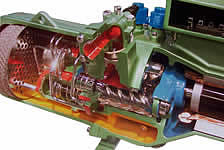
2. Reciprocating Compressor

3. Rotary Compressor
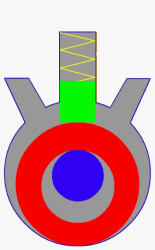
4. Scroll Compressor
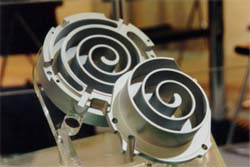
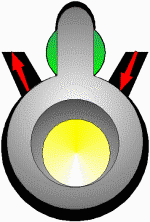
5. Swing Compressor
In 1995 Daikin developed the first swing compressor in the industry and applied it to their air conditioners.
The piston is moulded into a single body together with the blades and roller of the rotary compressor. This and the swing bushing keeps compression smooth. This mechanism minimises leaks from the blades and roller as well as friction caused by mixed lubricants. All in all, efficiency and reliability have both been improved. Thanks to the inverter application, efficiency and energy savings are high in the low to mid speed range.

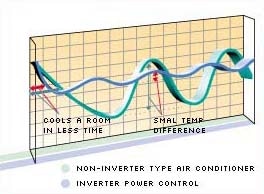
The amount of cooling or heating required by an air conditioner will vary depending on the outdoor temperature and the amount of heat in the room.
Conventional air conditioners operate their compressors at a fixed speed and therefore deliver a fixed amount of power. As a result the compressor must continually stop and start to maintain the desired room temperature. Inverter driven compressors, on the other hand, vary the speed of the compressors, delivering precise cooling or heating power as required.
When the compressor operates at a high speed, the amount of refrigerant flow through the system increases, increasing the cooling or heating capacity. Conversely, when the compressor operates at a low speed (during moderate outside temperatures for example), the amount of refrigerant flowing through the system decreases, thus decreasing the capacity.
When the inverter air conditioner is switched on, the compressor operates at a high speed in order to cool or heat the room quickly. As the room temperature approaches the set temperature, the compressor slows down, maintaining a constant temperature and saving energy. If there is a sudden fluctuation in the room temperature, the air conditioner senses this and instantly adjusts itself to bring the room temperature back to the set temperature.
Not only do Daikin inverter air conditioners use less electricity to operate, they are also highly energy efficient.
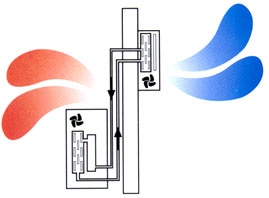
Cooling Mode
The refrigerant is the special liquid which flows through the indoor unit(s) to absorb the excess heat indoors. It then evaporates and is carried through narrow copper tubes to the outdoor unit as a gas, where the heat is released into the atmosphere. Thus, the gas becomes a liquid again and flows back to the indoor unit(s), where air is fanned over it and out into the room. This cycle is repeated until the preset temperature is reached.
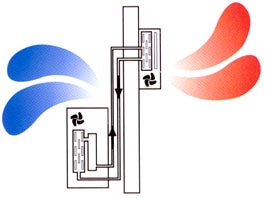
Heating Mode
Heat pump air conditioning units additionally allow the cycle described above to be reversed. A heat pump extracts “free” heat from the outdoor air and transfers the heat indoors. This principle even continues to function on very cold days with temperatures down to -5 °C, -10 °C or -15°C, depending on the type of air conditioning system used. Therefore, heat pump units eliminate the need for a heating system and allow you to cool and heat with the same unit, with savings in costs and energy throughout the year.

